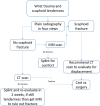Systematic Review of Diagnosis of Clinically Suspected Scaphoid Fractures
- PMID: 32025360
- PMCID: PMC7000269
- DOI: 10.1055/s-0039-1693147
Systematic Review of Diagnosis of Clinically Suspected Scaphoid Fractures
Abstract
Background Scaphoid fracture accounts for approximately 15% of acute wrist fractures. Clinical examination and plain X-rays are commonly used to diagnose the fracture, but this approach may miss up to 16% of fractures in the absence of clear-cut lucent lines on plain radiographs. As such, additional imaging may be required. It is not clear which imaging modality is the best. The goal of this study is to summarize the current literature on scaphoid fractures to evaluate the sensitivity, specificity, and accuracy of four different imaging modalities. Case Description A systematic-review and meta-analysis was performed. The search term "scaphoid fracture" was used and all prospective articles investigating magnetic resonance imaging (MRI), computed tomography (CT), bone scintigraphy, and ultrasound were included. In total, 2,808 abstracts were reviewed. Of these, 42 articles investigating 51 different diagnostic tools in 2,507 patients were included. Literature Review The mean age was 34.1 ± 5.7 years, and the overall incidence of scaphoid fractures missed on X-ray and diagnosed on advanced imaging was 21.8%. MRI had the highest sensitivity and specificity for diagnosing scaphoid fractures, which were 94.2 and 97.7%, respectively, followed by CT scan with a sensitivity and specificity at 81.5 and 96.0%, respectively. The sensitivity and specificity of ultrasound were 81.5 and 77.4%, respectively. Significant differences between MRI, bone scintigraphy, CT, and ultrasound were identified. Clinical Relevance MRI has higher sensitivity and specificity than CT scan, bone scintigraphy, or ultrasound. Level of Evidence This is a Level II systematic review.
Keywords: diagnostics; fracture; meta-analysis; scaphoid; systematic review.
© Thieme Medical Publishers.
Conflict of interest statement
Conflict of Interest None declared.
Figures
References
-
- Hey H W, Chong A K, Murphy D. Prevalence of carpal fracture in Singapore. J Hand Surg Am. 2011;36(02):278–283. - PubMed
-
- Shenoy R, Pillai A, Hadidi M. Scaphoid fractures: variation in radiographic views - a survey of current practice in the West of Scotland region. Eur J Emerg Med. 2007;14(01):2–5. - PubMed
-
- The classic. Injuries of the wrist. A radiological study. By Etienne Destot. 1926. Clin Orthop Relat Res. 1986;(202):3–11. - PubMed
-
- Cravener E K, McElroy D G. Fractures of the carpal (navicular) scaphoid. Am J Surg. 1939;44(01):8.
LinkOut - more resources
Full Text Sources
Research Materials



